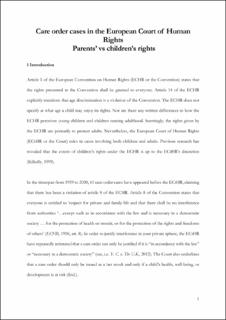| dc.contributor.author | Helland, Trond | |
| dc.contributor.author | Hollekim, Ragnhild | |
| dc.date.accessioned | 2023-05-05T07:53:16Z | |
| dc.date.available | 2023-05-05T07:53:16Z | |
| dc.date.created | 2023-05-04T09:36:37Z | |
| dc.date.issued | 2023 | |
| dc.identifier.issn | 0927-5568 | |
| dc.identifier.uri | https://hdl.handle.net/11250/3066356 | |
| dc.description.abstract | This article aims to examine the intersection where parents’ rights meet children’s rights in care order cases forwarded to the European Court of Human Rights, and how the court balances such rights in their rulings. The article reveals that both biological parents and children’s rights, in care order cases, are of less significance. It is the child’s interests which is the over-ruling argument. However, the article’s findings reveal that the biological parents’ standing in the ECtHR has increased in the latter years. Previous research has revealed that the ECtHR has turned towards a more child-centered approach in their deliberation (cf. ). This article argues that the ECtHR has taken a turn towards a more family-centered approach, rather than child- or parent-centered. | en_US |
| dc.language.iso | eng | en_US |
| dc.publisher | Brill | en_US |
| dc.title | Care Order Cases in the European Court of Human Rights. Parents vs. children's rights | en_US |
| dc.type | Journal article | en_US |
| dc.type | Peer reviewed | en_US |
| dc.description.version | acceptedVersion | en_US |
| dc.rights.holder | Copyright 2023 the authors | en_US |
| cristin.ispublished | true | |
| cristin.fulltext | postprint | |
| cristin.qualitycode | 2 | |
| dc.identifier.doi | 10.1163/15718182-31010007 | |
| dc.identifier.cristin | 2145336 | |
| dc.source.journal | The International Journal of Children's Rights | en_US |
| dc.source.pagenumber | 190-224 | en_US |
| dc.identifier.citation | The International Journal of Children's Rights. 2023, 31 (1), 190-224. | en_US |
| dc.source.volume | 31 | en_US |
| dc.source.issue | 1 | en_US |
